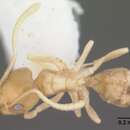en
names in breadcrumbs


This species occurs in lowland rainforest. It is arboreal, nesting in thin dead sticks or other small plant cavities in highly insolated microhabitats, such as forest edges or high in the canopy. For example, I observed one nest in the core of a thin, soft rotten stick. There was a small tubular chamber in the center, about 5cm long, that housed a total of 20 adult workers and one dealate queen. Most colonies I have seen have been polygynous, with multiple dealate queens in nests.
Bahamas, USA (Florida), Cuba, Dominican Republic, Puerto Rico, Jamaica, Costa Rica, Panama, Colombia. Costa Rica: lowland wet forests throughout the country.
Extant: 1 valid subspecies
Tapinoma litorale Wheeler, 1905c PDF: 109 (w.q.m.) BAHAMAS. Neotropic. AntCat AntWiki HOL
Tapinoma litorale is a species of ant in the genus Tapinoma. Described by William Morton Wheeler in 1905, the species is endemic to various countries in North America.[1]
Tapinoma litorale is a species of ant in the genus Tapinoma. Described by William Morton Wheeler in 1905, the species is endemic to various countries in North America.